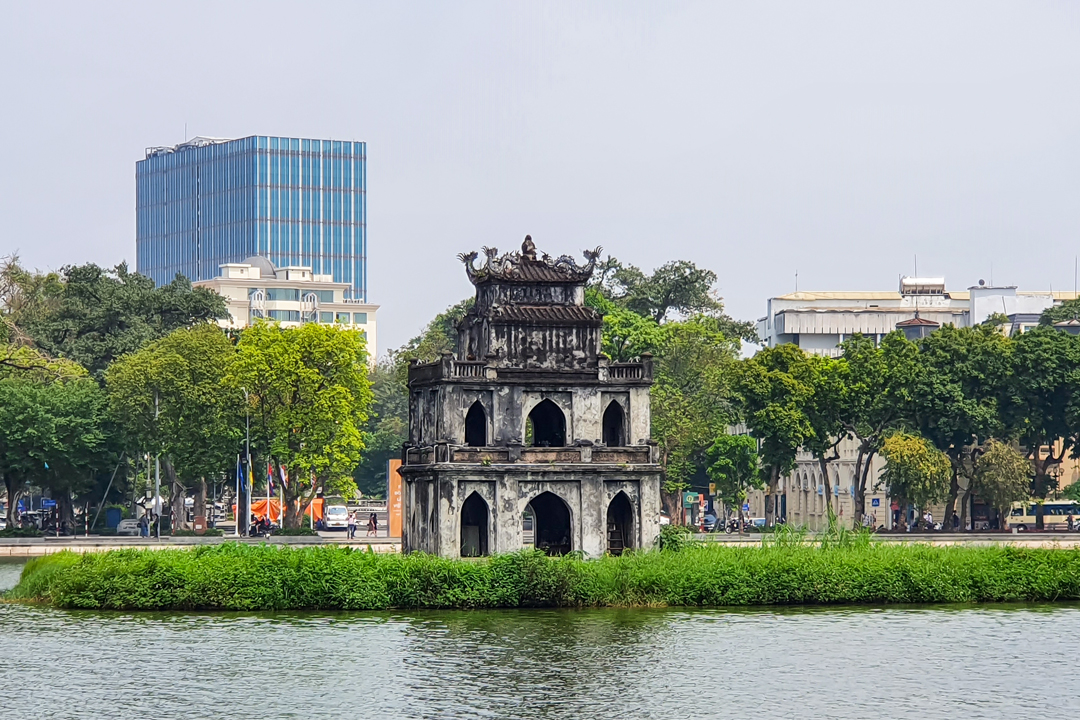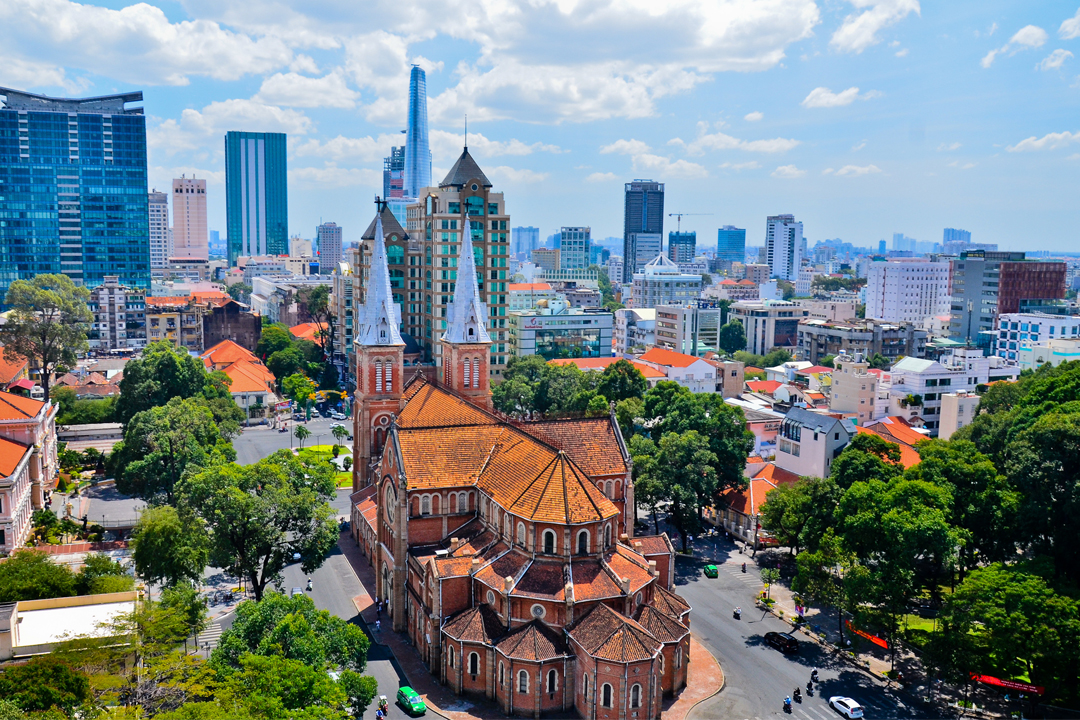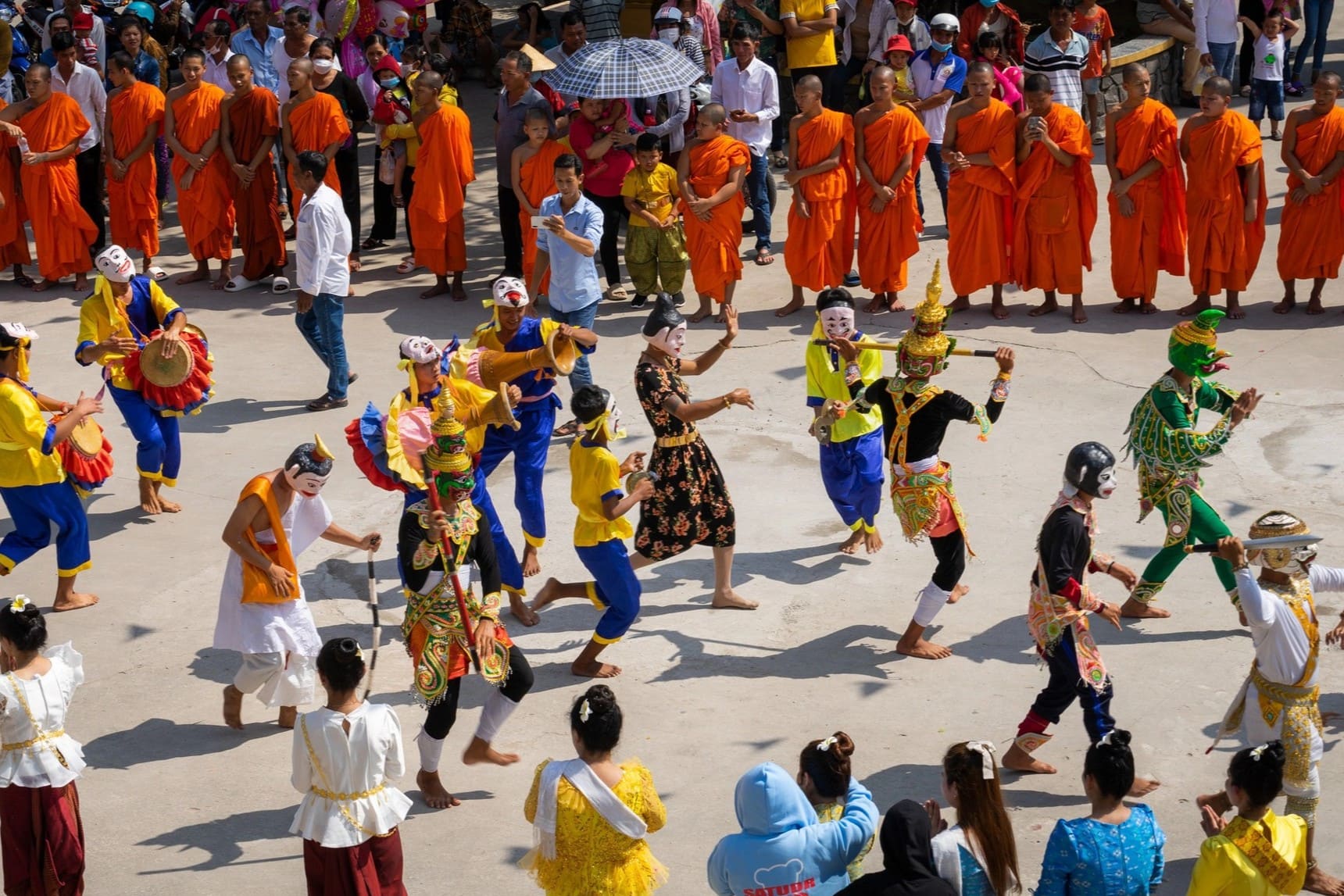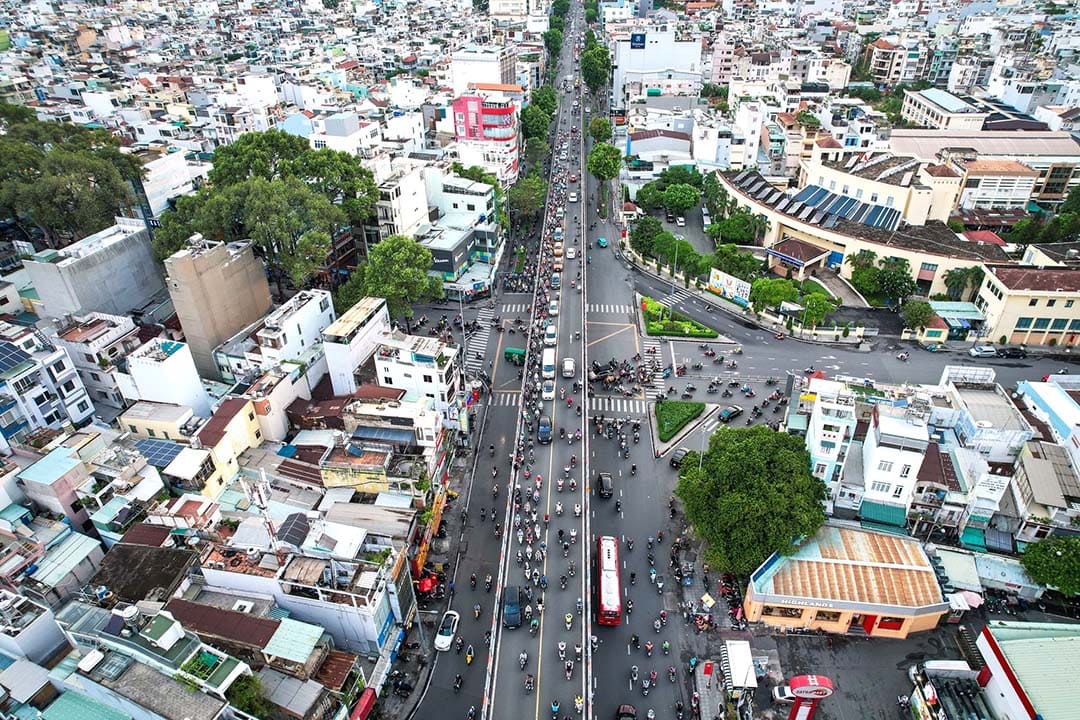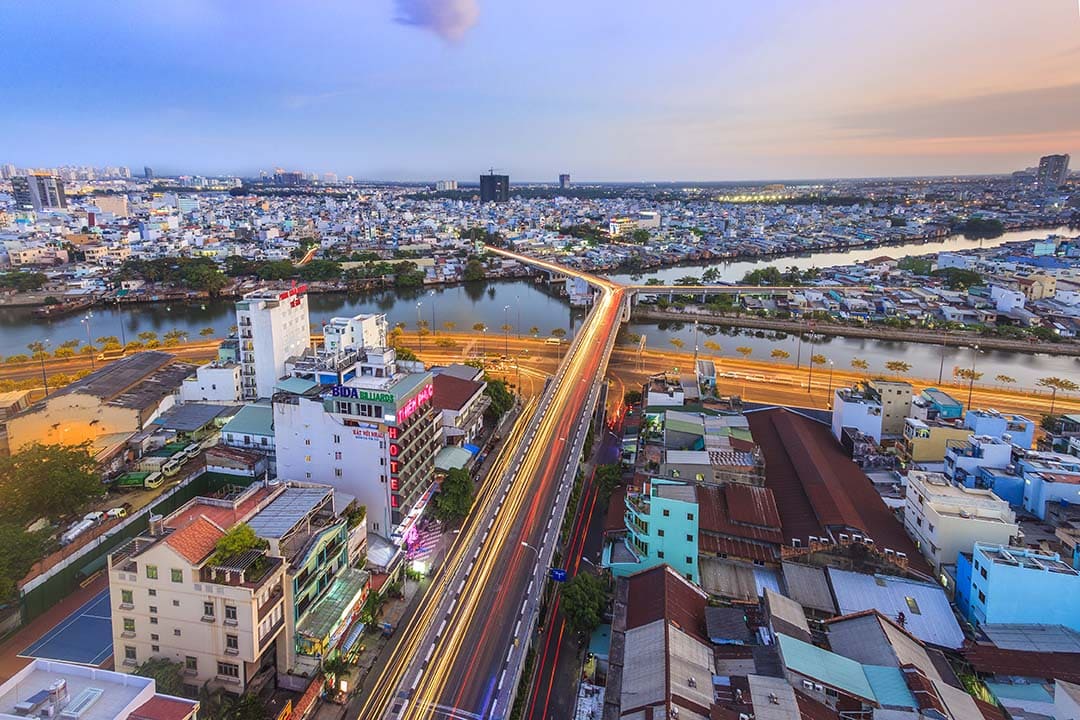Oct - 02 - 2025
The best way to experience the city is through walking tours in Hanoi, where you can explore the bustling Old Quarter, the elegant French Quarter, and hidden alleys rich with local flavors. A self-guided journey lets you stop where you please, linger at temples or cafes, and truly feel the city’s rhythm. Each step uncovers a unique mix of history, culture, and daily life. This guide features four carefully crafted routes, and with tips from the local experts at GTrip, you’ll discover the most authentic and unforgettable sides of Hanoi.
Introduction: Exploring Hanoi on foot
Hanoi is a city of striking contrasts, where ancient pagodas share space with elegant French-era boulevards, and the aroma of sizzling dishes from the famous foods in Hanoi mingles with the hum of motorbikes. While a cyclo ride or taxi can give you a quick glimpse, only by walking can you slow down enough to feel the city’s true rhythm. On foot, every corner reveals something new - from hidden alleyway markets and family-run cafes to quiet lakeside temples where daily life unfolds at a gentle pace. Walking connects you with the sights, sounds, flavors, and stories that make Hanoi unforgettable. It is this intimate perspective that makes self-guided walking tours the best way to discover the capital’s authentic soul.
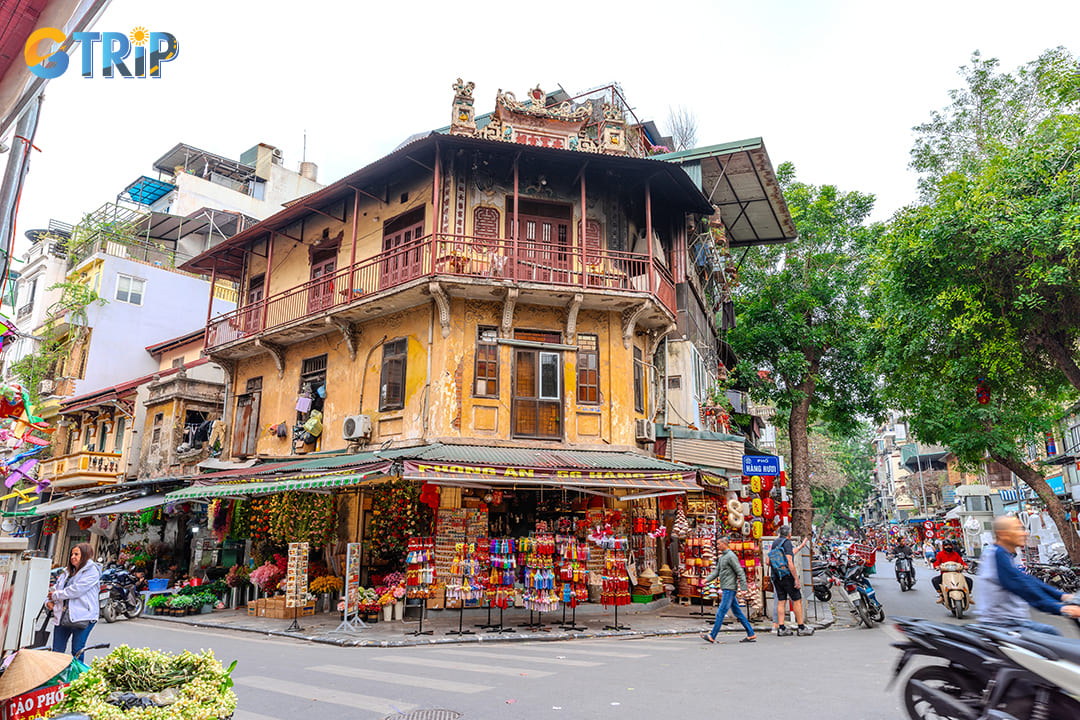
You can feel the pace and also the vibe of Hanoi by walking around this city
Essential preparation for your Hanoi walking tour
Good planning is the secret to turning a simple walk into a memorable journey. A few tips will help you experience Hanoi at its best-starting with when to walk.
Best time of day to walk
To make the most of your walking tour, timing is everything. Avoid the intense midday heat and rush-hour traffic for a more pleasant experience.
- Early morning (6:00 AM - 9:00 AM): The city is at its most serene. You'll witness locals practicing tai chi by the lake, markets coming to life, and enjoy the cool, fresh air. This is the perfect start for any Hanoi walking adventure.
- Late afternoon (4:00 PM - 6:30 PM): The sun is less harsh, casting a beautiful "golden hour" light perfect for photography. The city begins to buzz with evening activity, offering a vibrant atmosphere.
What to wear and bring
Comfort is key to enjoying a day of exploring on foot. Here’s a checklist of essentials for your self-guided walking tour in Hanoi:
- Comfortable walking shoes: This is non-negotiable. You'll be walking on uneven pavements.
- Light, breathable clothing: Choose materials like cotton or linen.
- Modest attire: Pack a light scarf or sarong to cover your shoulders and knees when visiting temples and pagodas.
- Sun protection: A wide-brimmed hat, sunglasses, and high-SPF sunscreen are essential.
- Hydration: Carry a reusable water bottle to stay hydrated throughout the day.
- Essentials: A portable charger for your phone, a map (or offline map app like Google Maps), and some cash to enjoy the best street foods in Hanoi.
Safety and general etiquette
Navigating Hanoi streets is an adventure in itself. Keep these tips in mind for a smooth and respectful journey:
- Crossing the street: This can seem daunting. The trick is to walk at a steady, predictable pace. Make eye contact with drivers and let the traffic flow around you. Do not make sudden stops or run.
- Be aware of your surroundings: Keep your valuables secure, especially in crowded market areas.
- Respect local culture: Ask for permission before taking close-up photos of people. When visiting religious sites, speak softly and be mindful of your actions. A simple "Xin chao" (hello) and "Cam on" (thank you) will be warmly received.
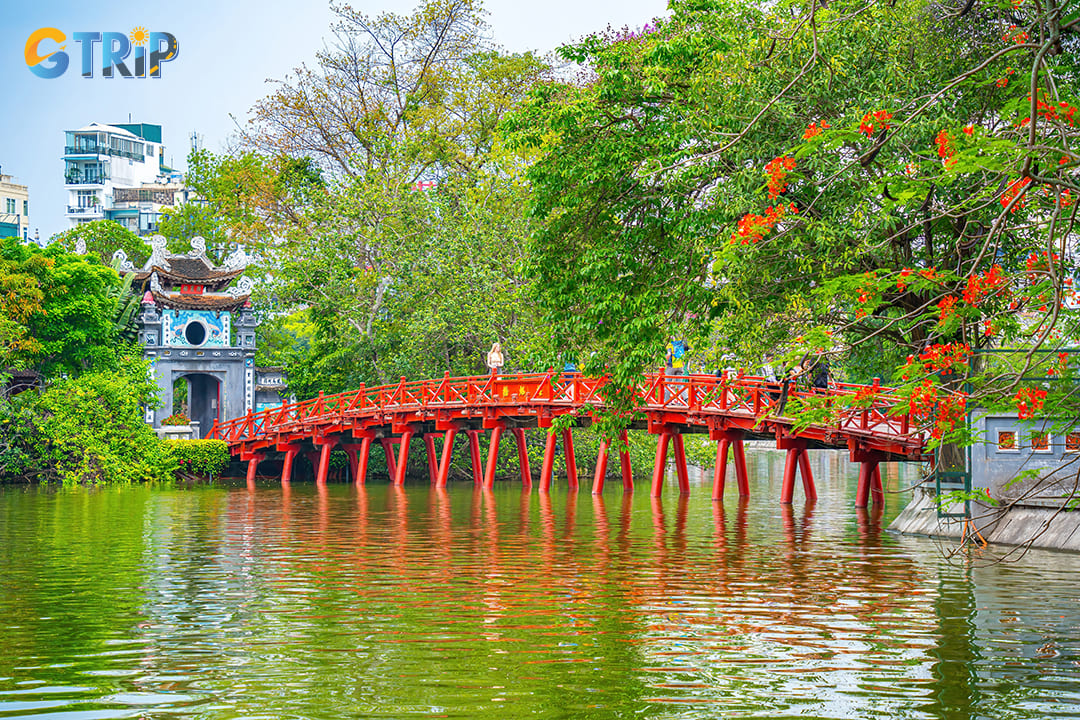
Having a clear preparation before starting your walking tour in Hanoi is very essential
Route 1: The historic heart of the Old Quarter
- Estimated distance: ~2.5 km
- Walking time: ~3 hours (including visiting time)
- Starting point: St. Joseph's Cathedral
1. St. Joseph's Cathedral
Our journey begins at St. Joseph's Cathedral, a slice of old Europe situated right in the heart of Hanoi. With its characteristic 19th-century Gothic architecture, the cathedral's solemn, moss-covered facade offers a fascinating contrast to the bustling energy of the surrounding cafes and traffic. It's the perfect starting point to experience the intersection of the city's tranquil and dynamic sides.
Insider tip: The small cafes opposite the cathedral offer a perfect vantage point for photos and a glimpse into the local cafe in Hanoi culture.
2. Ngoc Son Temple & The Huc Bridge (approx. 900m away)
From the cathedral, a short 900-meter walk will take you to the "Heart of Hanoi": Ngoc Son Temple. This walk leads you to the open expanse of Hoan Kiem Lake, where the iconic, crimson The Huc Bridge guides you into another world. The temple is associated with the legend of the Golden Turtle reclaiming the magic sword and is a significant spiritual space. Once inside, don't miss the preserved specimen of the legendary giant turtle on display. Note that there is a small entrance fee, so you should have some cash ready.
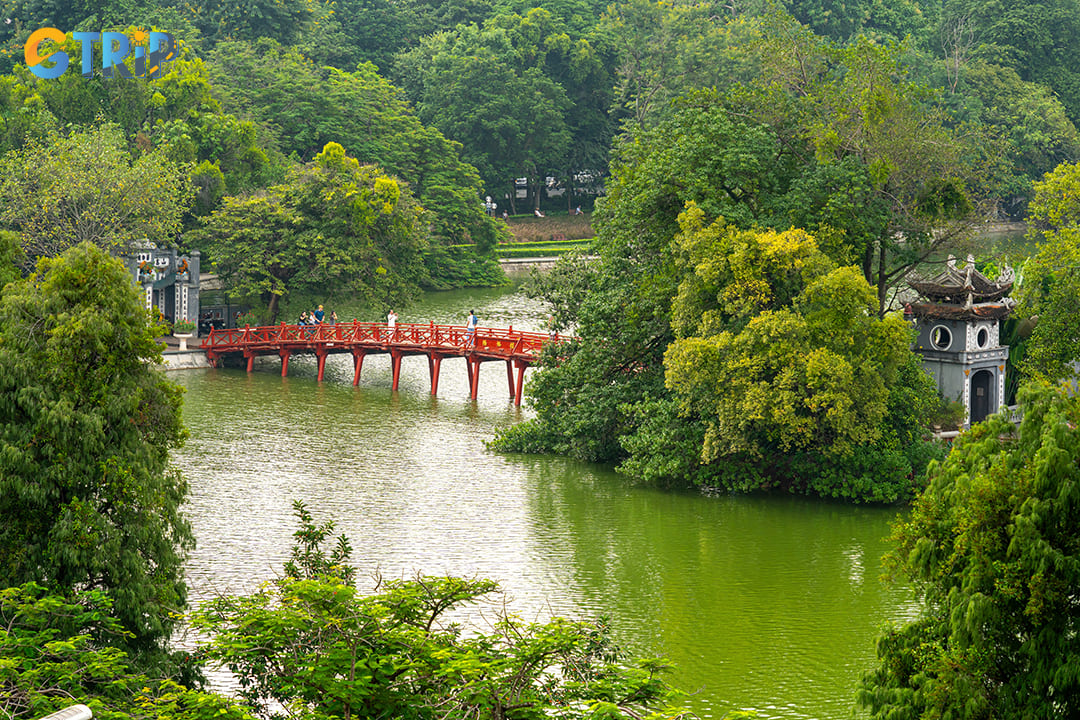
Ngoc Son Temple on Hoan Kiem Lake welcomes you with the iconic red bridge, legendary turtle tales, and a touch of Hanoi’s spiritual heart
3. Ma May Ancient House (approx. 600m away)
Continuing deeper into the core of the Old Quarter, the next stop, about 600 meters away, is the Ma May Ancient House. This is the best-preserved example of the characteristic "tube house" architecture, allowing you to understand how Hanoians of the past optimized their narrow living spaces with clever courtyards (or "sky wells") for light and ventilation. Stepping inside, you'll feel a quiet atmosphere, completely separated from the hustle and bustle outside. This is a must-see on most walking tours in Hanoi, especially around its historic areas.
4. Bach Ma Temple (approx. 400m away)
Just 400 meters from the Ma May Ancient House is Bach Ma Temple, one of the four sacred "guardian temples" of the ancient Thang Long Citadel. The path here offers two experience options: walk along Luong Ngoc Quyen street or take a detour through Hang Bac street to discover the traditional silversmith craft. The temple has a modest entrance and can be easily missed among the packed storefronts, so keep a sharp eye out.
5. O Quan Chuong Gate (approx. 350m away)
Our first walking tour in Hanoi ends at O Quan Chuong, the last remaining gate of the ancient Thang Long Citadel. The feeling of seeing the ancient gate standing majestically amidst modern traffic is an impressive experience, encapsulating the city's tumultuous history. It is a powerful historical witness and a fitting end to this walking tour.
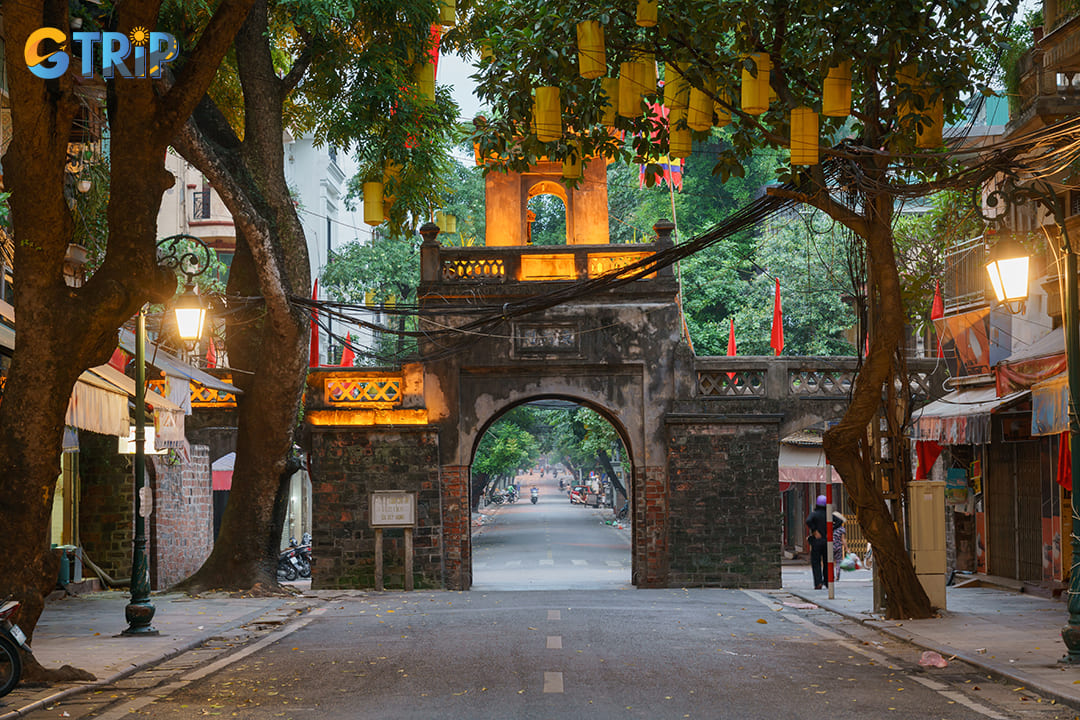
O Quan Chuong, the last gate of ancient Thang Long Citadel, stands proudly amid modern Hanoi, offering a poignant glimpse into the city’s storied past
Route 2: The architectural elegance of the French Quarter
- Estimated distance: ~1.7 km
- Walking time: ~2 hours (including sightseeing)
- Starting point: Hanoi Opera House
1. Hanoi Opera House
Our second Hanoi walking tour begins at the Hanoi Opera House, a neoclassical masterpiece often referred to as a “miniature Opera Garnier” of Paris. Take a moment to admire its magnificent facade, adorned with intricate details. This landmark is a symbol of a flourishing cultural and artistic era and the perfect place to immerse yourself in the elegance of Hanoi’s French Quarter.
2. Sofitel Legend Metropole Hanoi (~200m)
From the Opera House, cross the roundabout at August Revolution Square and head onto Ly Thai To Street. About 200 meters away, on your left, stands the legendary Sofitel Legend Metropole, a hotel with over a century of history, having welcomed countless world-famous figures. Its graceful white facade and timeless charm make it more than just a hotel; it is a living witness to Hanoi’s past. The luxurious, old-world atmosphere is an essential part of the French Quarter experience.
3. State Bank of Vietnam (200m)
Continue walking about 200 meters from the Metropole along Ngo Quyen Street, and you’ll reach a roundabout where the State Bank of Vietnam stands proudly. This impressive colonial-era building, with its sturdy rows of columns and grand architecture, is a striking example of French colonial design. It reflects the economic and financial power of its time and forms, along with the Opera House and the Metropole, a “power triangle” of architecture right in the heart of the capital.
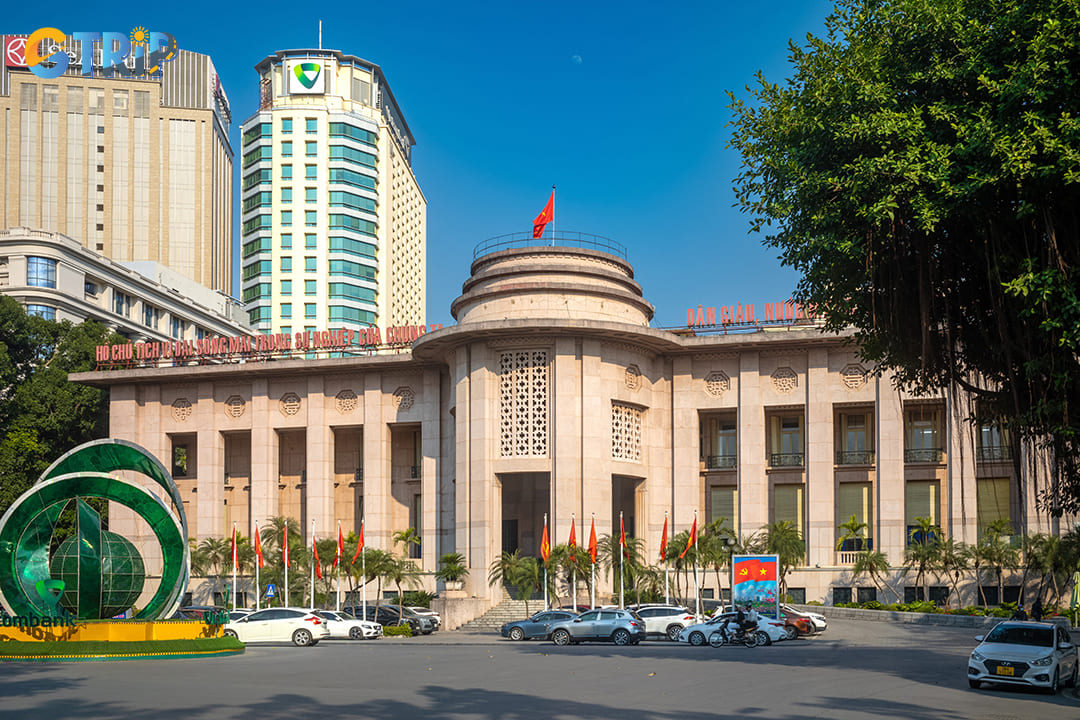
The State Bank of Vietnam forms a historic ‘power triangle’ alongside the Opera House and Metropole Hotel
4. National Museum of History (~600m)
Located just behind the Opera House, the National Museum of History is our next stop. This building is a masterpiece of Indochinese architecture, harmoniously blending French design with traditional Vietnamese decorative elements. It's one of the most important museums in Hanoi and a convenient addition to this walking route.
Don't miss: The museum's collection of ancient Dong Son drums.
5. A stroll down Trang Tien Street & enjoying Trang Tien ice cream (500m)
After exploring the landmarks around the Opera House, we head west along the spacious, tree-lined Trang Tien Street. This is more of an experience than a single stop, a street lined with luxury boutiques, art galleries, and bookstores. Be sure to pause at 35 Trang Tien to savor the famous Trang Tien ice cream, a sweet treat considered one of the famous desserts in Hanoi and a taste of nostalgia for many Hanoians.
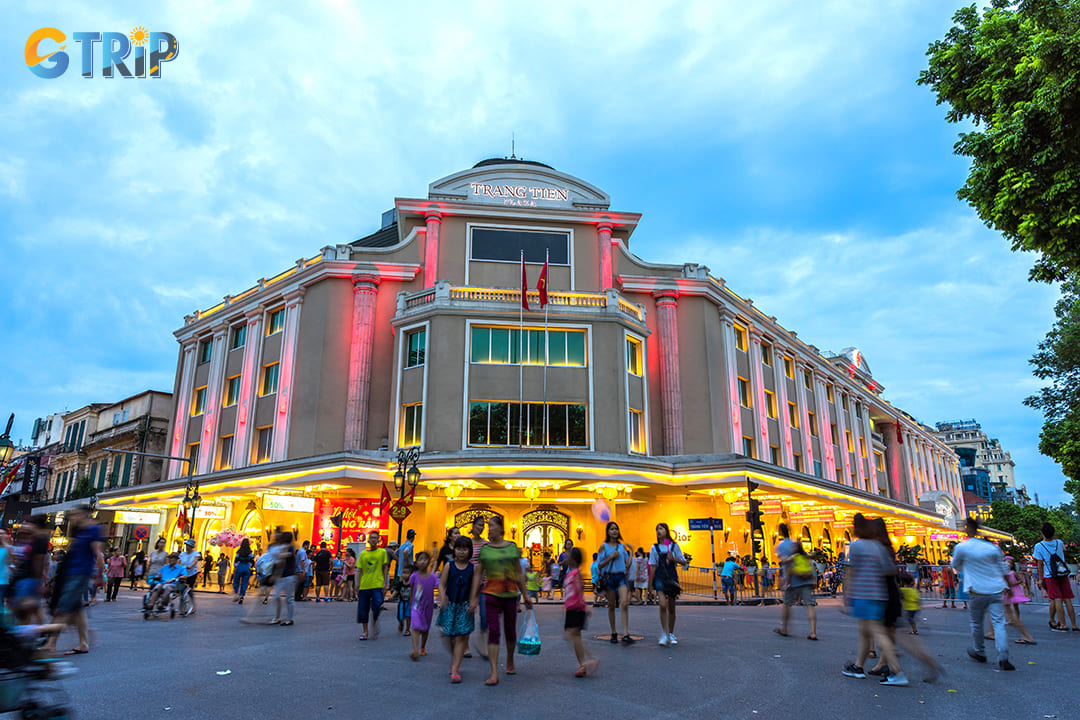
Remember to have a leisure stroll on Trang Tien Street and enjoy the ice cream
Route 3: The historical charm of Hanoi
- Estimated distance: ~3.25 km
- Duration: ~3 hours (including sightseeing time)
- Starting point: Phung Hung Mural Street
1. A poetic start at Phung Hung Mural Street
Begin your day in an art-filled space at Phung Hung Mural Street. Here, ancient railway arches have been given a new lease on life with vibrant murals telling the story of old Hanoi. It's a fantastic, artistic way to kick off one of the most insightful walking tours in Hanoi.
2. Strolling down Phan Dinh Phung Boulevard & admiring the Cua Bac heritage site (~850m away)
From Phung Hung Street, you will step onto Phan Dinh Phung street, one of Hanoi's most romantic boulevards. A walk of about 850m under shady, ancient dracontomelon trees will lead you to a nearby historical complex:
- The North Gate (Chinh Bac Mon): This is the only remaining gate of the ancient Hanoi Citadel, a silent historical witness that still bears the bullet marks from the French attacks in the past.
- Cua Bac Church: Located directly across the street, just 140m away, is a striking yellow Cua Bac Church Hanoi, a masterpiece of a unique fusion between Asian and European architectural styles.
3. Returning to the roots at the Imperial Citadel of Thang Long (~1km away)
From the Cua Bac area, continue walking south along Hoang Dieu Street for about 1km, and you will arrive at the main entrance of the Thang Long Imperial Citadel. This is a massive architectural complex, recognized by UNESCO as a World Heritage Site, which preserves the invaluable historical and cultural values of the nation through the millennia. Take your time to explore important relics such as the Doan Mon (Main Gate), Kinh Thien Palace, and the 18 Hoang Dieu archaeological site to feel the heroic flow of history.
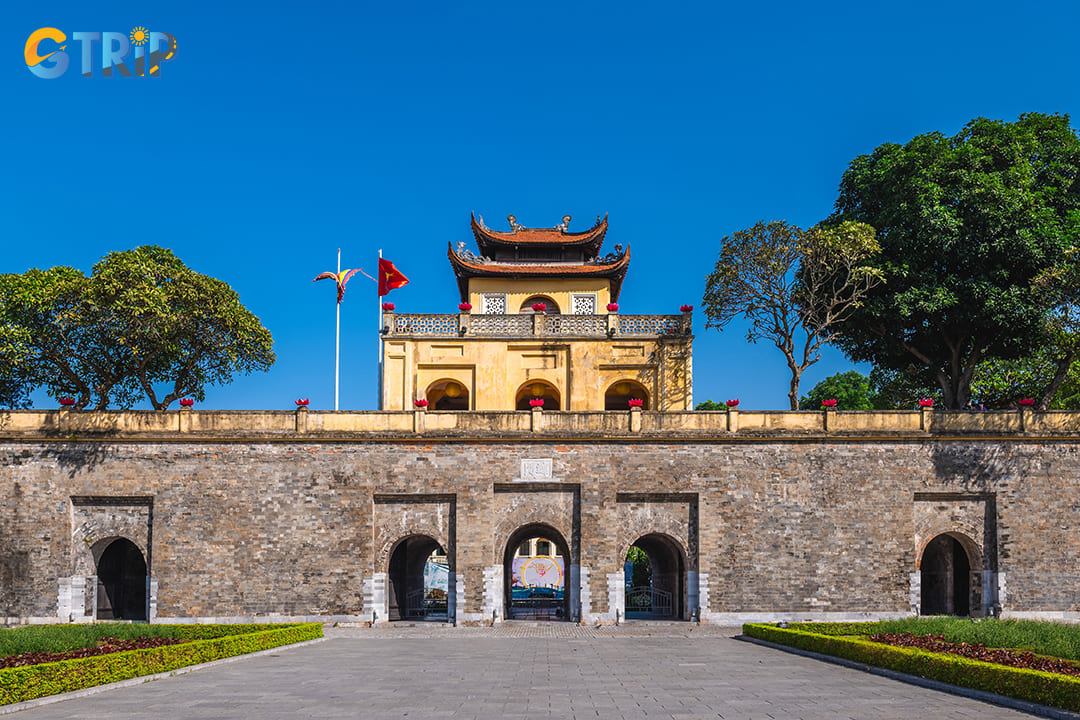
Doan Mon is the main gate to the Imperial Citadel of Thang Long in Hanoi
4. Reaching the proud symbol - the Hanoi Flag Tower (~400m away)
After exploring the Imperial Citadel, find the exit back to Hoang Dieu Street, head south for about 400m, then turn right onto Dien Bien Phu Street. The majestic Hanoi Flag Tower will appear right before your eyes, located within the grounds of the Vietnam Military History Museum. As one of the city's icons, you can enter the grounds to get closer to the base of the tower and watch the red flag with a gold star waving proudly. Opposite the Flag Tower stands the solemn statue of Lenin.
5. A moment of reflection at the historic Ba Dinh Square (~1km away)
From the Hanoi Flag Tower, a mere 1km walk northwest along Dien Bien Phu Street will bring you to the vast and solemn space of Ba Dinh Square. This is the political heart of Vietnam, home to the Ho Chi Minh Mausoleum. Concluding your trip in this sacred space is a perfect way to wrap up a journey from the ancient and medieval history of Thang Long to the glorious modern history of Vietnam, making it a memorable stop on many walking tours in Hanoi.
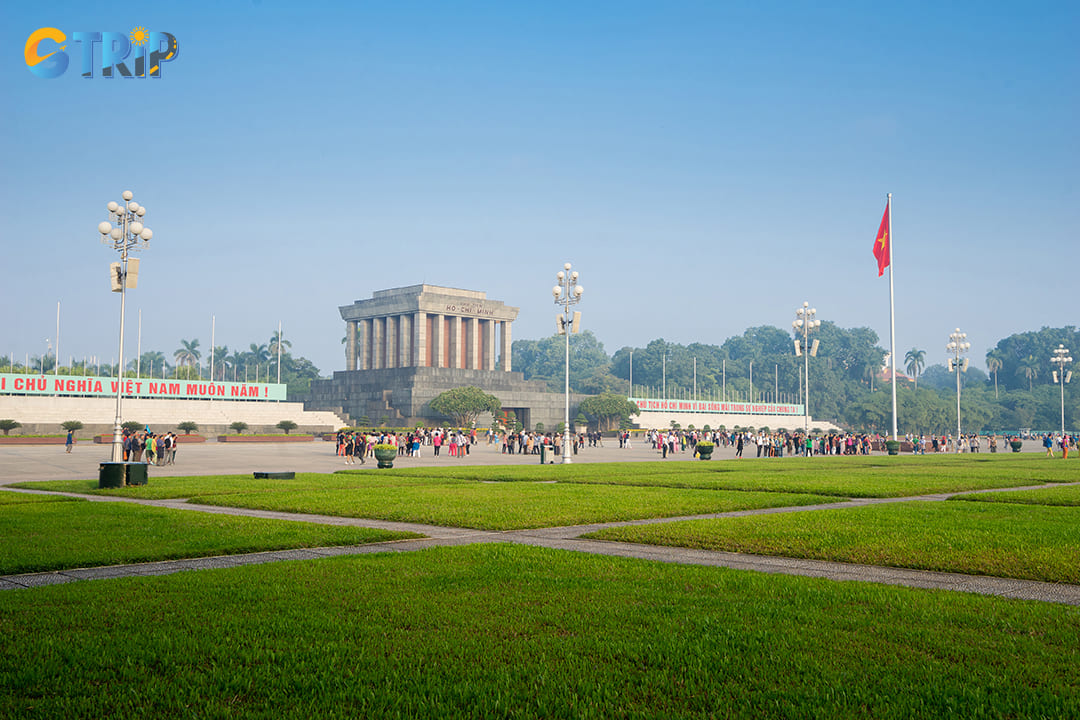
Ba Dinh Square is a must-visit destination that you can walk to
Route 4: Exploring the specialty goods streets and Dong Xuan Market
- Estimated distance: ~1.7 km
- Walking time: ~2.5 hours (including coffee break and visiting time)
- Starting point: Cafe Dinh (13 Dinh Tien Hoang St.)
1. Start with an egg coffee at Cafe Dinh
Our journey begins at Cafe Dinh, a legendary spot hidden on the second floor of an old building overlooking Hoan Kiem Lake. Find the narrow staircase and step into a space steeped in old Hanoi charm. Enjoying authentic egg coffee in Hanoi, with its rich, creamy foam atop a robust coffee base, is the perfect way to energize and watch the city's rhythm from above before starting your walk.
2. Hang Gai Street - The silk street (approx. 200m away)
After leaving the cafe, go down the stairs and turn left onto Dinh Tien Hoang Street. Walk a short distance along the lake, and you will see the three-way intersection with Hang Gai Street directly in front of you. Hang Gai Street has long been famous as the "Silk Street" of Hanoi. This is the best place if you are looking for where to buy silk in Hanoi, from soft fabrics and scarves to exquisitely tailored traditional Ao Dai. Take your time to admire the intricate hand-embroidered products that showcase the skill of local artisans.
3. Hang Bac Street (the silversmith street) (approx. 400m away)
Continue along most of the length of Hang Gai Street, which will naturally lead you to a three-way intersection with Hang Bac Street. Turn right to begin exploring. This is the traditional center of silver and goldsmithing. Walking along both sides of the street, you will see countless sparkling jewelry shops. However, listen closely, and you might hear the clinking of hammers from small workshops where artisans are still maintaining their ancestral craft.

You can start your walking tour in Hanoi with a cup of egg coffee
4. Hang Duong Street (the preserved fruits & sweets street) (approx. 500m away)
Walk nearly the entire length of Hang Bac Street until you reach the major intersection with Hang Ngang - Hang Dao Street. Carefully cross the road and walk straight ahead; you will now be on Hang Duong Street. The atmosphere here changes instantly with a characteristic sweet aroma. This street is a "paradise" for traditional Hanoi preserved fruits (O Mai), jams, and candies. Large shops stand side by side, displaying dozens of different types of O Mai in large glass jars, offering a full range of sweet, sour, salty, and spicy flavors. This is an excellent stop for anyone wondering what to buy in Hanoi as souvenirs.
5. Hang Ma Street (the votive paper & decorations street) (approx. 250m away)
From Hang Duong Street, continue walking straight. The street will automatically transition into Hang Ma Street, which you'll recognize immediately by the vibrant change in colors from the decorative goods. This street specializes in votive paper and festive decorations. It's like a stage that constantly changes its colors with the holidays throughout the year: the brilliant red of Tet (Lunar New Year), the golden orange of the Mid-Autumn Festival, and a wide variety of lanterns. Even if you don't buy anything, walking through here is a stunning visual experience.
6. Dong Xuan Market (approx. 350m away)
Walk to the end of Hang Ma Street, and you will see the massive facade of Dong Xuan Market right in front of you. Dong Xuan Market is the largest wholesale market in Hanoi. While you may not be shopping, observing the bustling, hurried atmosphere of trade, with carts and goods moving constantly, is a worthwhile experience to understand the city's commercial pulse and a great end to this specialty street walking tour.
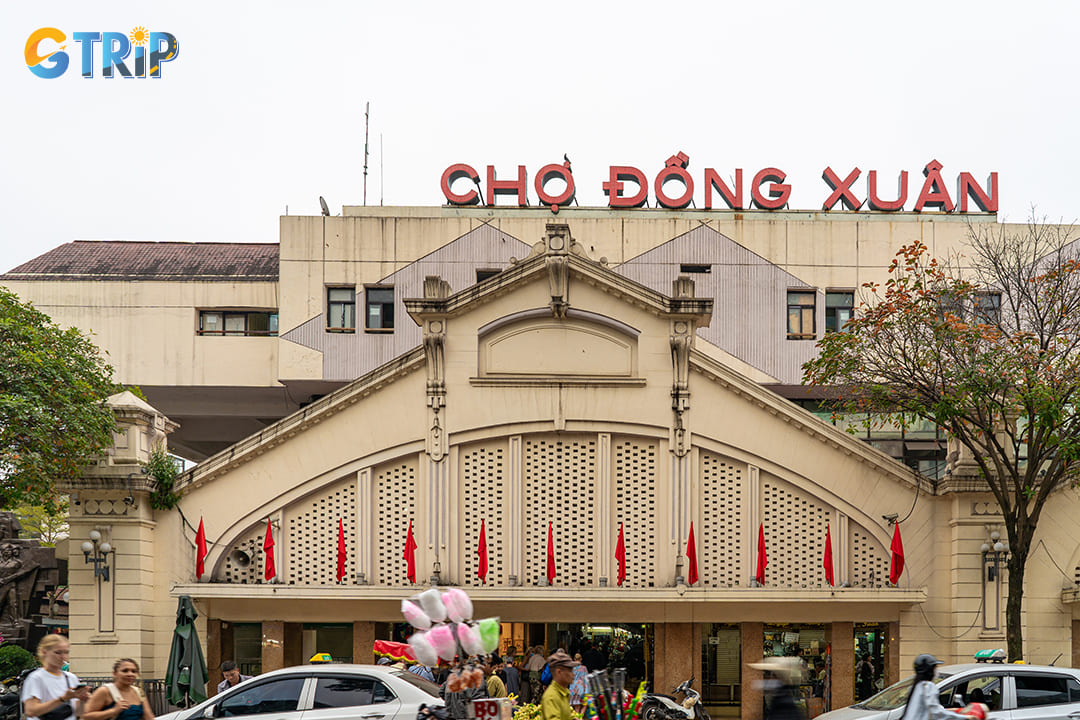
You should visit Dong Xuan Market to go shopping
Frequently asked questions (FAQ)
1. How to cross the street safely amid Hanoi’s chaotic traffic?
The key is to be confident and predictable. Wait for a slight gap, then walk slowly and steadily across the street. Do not stop suddenly or run. The motorbike riders are experts at navigating around pedestrians who move at a consistent pace. Make eye contact if possible.
2. What is the best time of year for walking in Hanoi?
The most pleasant seasons for walking are autumn (September to November) and spring (March to April). During these months, the weather is mild, with less rain and lower humidity, making it ideal for spending hours outdoors on foot.
3. Is walking in Hanoi safe?
Yes, Hanoi is generally a very safe city for tourists to walk around, even at night in the main areas. However, like in any major city, you should always be aware of your surroundings. Watch out for petty theft like pickpocketing in crowded markets and keep your belongings secure. The biggest safety concern is the traffic, so always be cautious when crossing streets.
4. Should I carry cash, or are credit cards widely accepted?
You should carry cash (Vietnamese Dong). While larger establishments accept cards, cash is essential for street food, local markets, and temple entrance fees. Knowing where to exchange money in Hanoi beforehand is also helpful.
5. What are the dress code rules for visiting temples and pagodas?
Yes, modest clothing is required to enter temples, pagodas, and other sacred sites (including the Ho Chi Minh Mausoleum Complex). Your shoulders and knees must be covered, so avoid shorts, short skirts, or tank tops. Bringing a light scarf or sarong is a smart idea, as you can easily use it when needed.
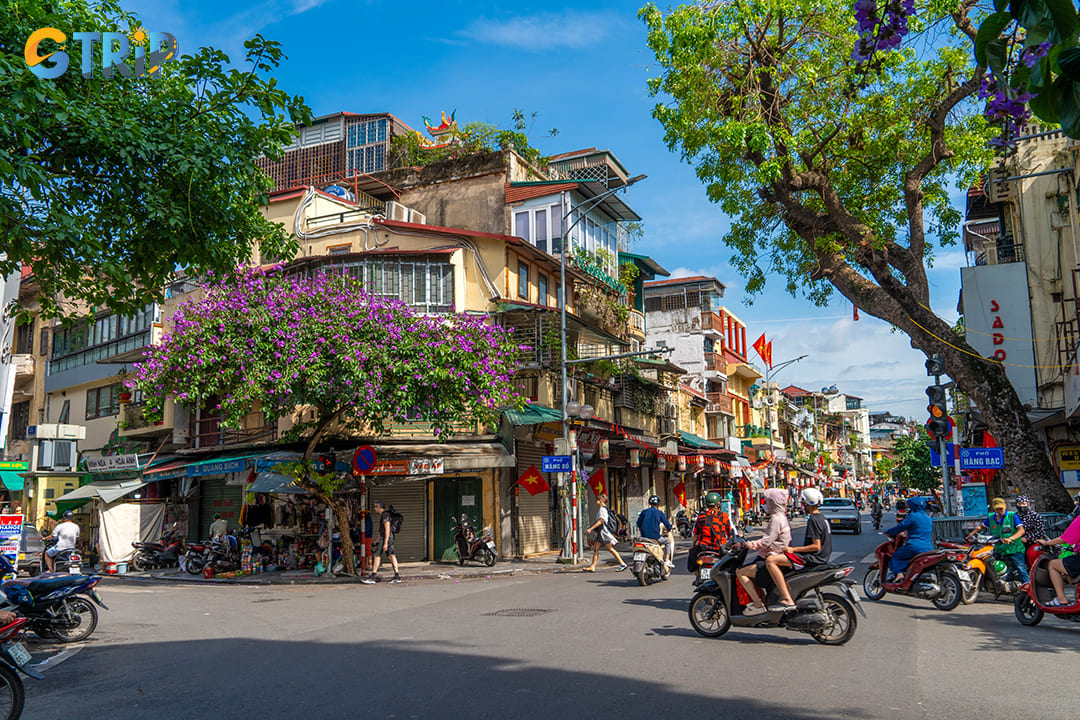
Hanoi is safe for walking around and exploring many different places
Read more:
Exploring Hanoi on foot is more than just sightseeing. It’s about immersing yourself in the city’s unique rhythm of history, culture, and daily life. With these four carefully crafted walking tours in Hanoi, you can discover everything from ancient temples and colonial landmarks to lively markets and hidden alleys. Each route offers an authentic and unforgettable experience. For a smoother journey, let GTrip - Vietnam Travel Agency be your trusted local guide, helping you uncover the most genuine sides of Hanoi one step at a time.

